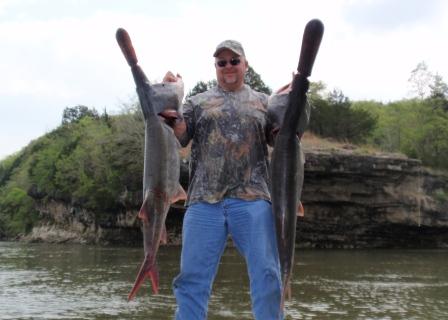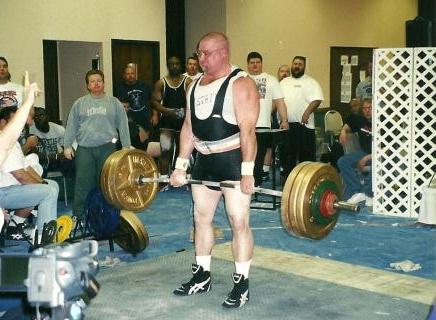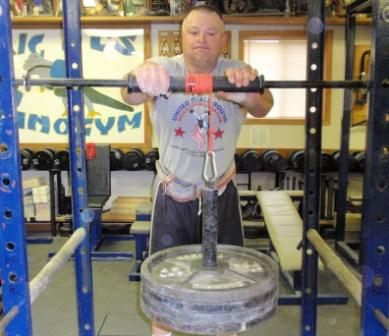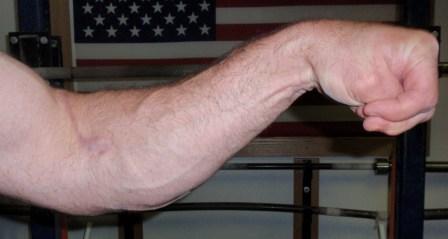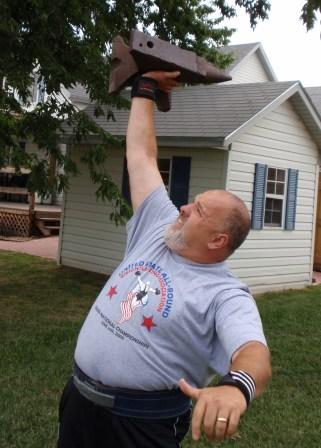by Al Myers
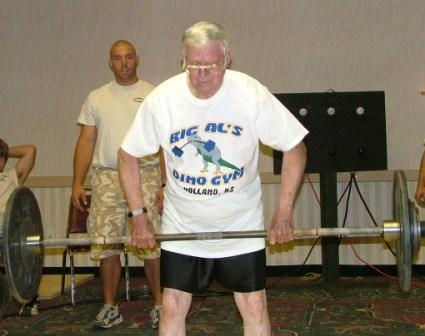
My Grandfather Clyde Myers deadlifting 100 pounds at the 2006 USAWA National Championships. He is the oldest lifter (at age 90) to have EVER competed at the USAWA Nationals.
Yesterdays lead in question of “who was the oldest USAWA member to ever compete in an USAWA National Championships?” brings me to a story I would like to tell. Actually, this is a story I have wanted to tell for a long time but just now am ready to tell it. This lifter was none other than my Grandfather Clyde Myers. Gramps competed at the 2006 USAWA National Championships at the age of 90. I was the promoter of this meet, and he really wanted to compete to show his support to me and our organization. Grandpa was not a lifetime weightlifter, but his years of manual labor as a farmer built his strength beyond that of “normal people” his age. He was very active up till his death at age 92, on August 5th, 2008. He was born on September 30th, 1915. The last 8 years of his life he lived with me and my family. Grandpa was always a very active man, and seemed to always be in great physical shape. Now living with me, he started to take interest in my weight training. Nearly every week he would spend time in the gym with me, and often he would do some light weight training. He began to love exercise. I know he would have been a great weightlifter if he would have had the opportunity to lift when he was younger. But in his day the notion of physical exertion for the “fun of it” or for “health reasons” was looked down upon by those in the farming community. Farming was so physically exhausting at that time it was felt you should be saving your strength for the work at hand, and use it for something beneficial, like providing a living for your family. I remember as a kid when I first started weight training Grandpa didn’t understand why I would be wasting my time picking up a barbell when all I really needed to do was go out in the plowed field with him and pick up rocks all day! That was the way he was brought up. It wasn’t until he retired and was living with me till he discovered what “physical culture” really meant. His days of hard farm work was behind him and he soon realized that exercise was the “spice of life” and that if he spent his days doing some light weight training and exercise he felt better.
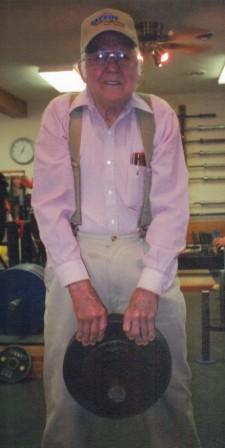
Clyde Myers with his World Record 2-Hand Pinch Grip of 66 pounds at the 2006 Dino Gym Record Day.
Grandpa Clyde usually did my record day every year, and joined the USAWA because of it. He liked the idea of breaking or setting records and since he was in an age group where it is slightly easier (not too many records in the 85 and 90 age brackets) to get a record, it was a sure thing he was going to “come away” with a few. He especially liked the grip lifts because he could lift weights in these lifts comparable to younger age groups. His best USAWA records are a 66# Pinch Grip, 118# Right Hand 2″ bar Vertical Bar Deadlift, and 134# 2 bar 2″ Vertical Bar Deadlift. All of these records were set in the 90-94 age grouping, 80-85 kilogram classes. He also was very proud of his grip strength in the Hand Dynamometer. A Hand Dynamometer is a hand held device that measures your grip strength in pounds and kilograms. Dale Harder has made this device well known in his books as he keeps track of ranking lists with it. In one on his latest books, Strength and Speed published in 2009, he lists Clyde Myers as the best of ALL-TIME in the One Hand Dynamometer with a grip reading of 42 kilograms for someone over 90 years of age. He also holds the ALL-TIME World Record in the One-Hand Partial Deadlift for a lifter over the age of 90, with a fine lift of 205 pounds. In this lift, a chain and handle is attached to a bar and the bar is only lifted an inch or so off the floor. This record is also included in Harder’s book. His 66# Pinch Grip is also listed as a World Record for lifters over 90. It is interesting to note that the 80 plus age group Pinch Grip World Record is held by the famous Australian Strongman Harry White, with a lift of 72 pounds. I witnessed this lift of Grandpa’s as I judged it at one of my record days and I can tell you it was a sub-maximal effort. He had never done a Pinch Grip before and I loaded it up for him thinking it would be “about right” for him and he did it easily. He didn’t try anymore. In fact, he only took that one attempt and it was the World Record!! When his records came out in Dale’s listings, he was very proud of it and made me make a photocopy of it so he could show his friends!
I was quite surprised when he said he wanted to enter the Nationals I was hosting. I didn’t pressure him at all to do it. Besides my little record days, this was the only official meet he ever entered. Several of the lifts in this meet were very difficult – lifts like the Steinborn and the one arm Snatch. I was a little worried that he wouldn’t be able to EVEN do the lifts! But he surprised me and won Best Lifter for the over 90 age group (uncontested of course) and received a nice plaque for his efforts. Again, this made him feel very good about what he had done, and it was well deserving, because he did what no one else has ever done, and that is competing in a difficult National Championships in the USAWA over the age of 90. Others may eventually do it, but he will always be the first.
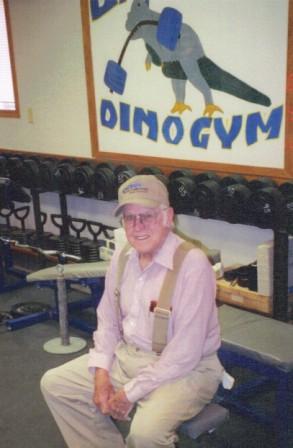
Grandpa in front of the Dino Gym Sign, which he drew and painted.
Most people don’t know this outside of the Dino Gym, but my Grandfather was a self-taught artist and was the one who drew the Dino Gym Logo. I told him what I wanted and he went to work. It was done entirely free hand and his first copy was the one we used! It was perfect from the start. The Dino Gym contains the original sign which he created. When I first had T-Shirts made with the Dino Gym Logo on them he was amazed. It was the first time (and only time) that one of his drawings was on a shirt! That means alot to me now, and I often wonder how he would feel if he knew how many lifters are wearing the Dino Gym Shirts around today.
My Grandfather was very eccentric in lots of ways (I know I am too – so that’s where it probably came from!). He was also an inventor and craftsman and built lots of interesting and unique things in his life. As he got interested in physical exercise he decided to “invent” an exercise device that catered to the elderly. Most older people can’t do the exercises (like riding a stationary bike or walking on a treadmill) that younger people can do. Grandpa designed and built a very interesting seated machine that allowed a combination of cardiovascular training, flexibility training and resistance training all at the same time. He “marketed” it to the local nursing homes and sold several of them. I’m sure some are still in use today helping elderly patients in physical rehabilitation. He picked a novel name for it – as he called it “The Exerciser”! He considered himself the testimony of it and would always do the demonstrations himself when selling a unit. How can anyone argue with the sales pitch when a 90 year old is making it look easy and appears in great shape??? He trained on it three times per day – every day. The Exerciser kept getting more complex as he kept adding new parts to it to do different movements. (I’m sure this story explains a little about myself for those that have seen my Dino Gym). Grandpa always wanted to get a patent on it but never took the time to make that happen, as he was too busy thinking of the NEXT thing he wanted to build. This was just one of the many original things that he built in his lifetime.
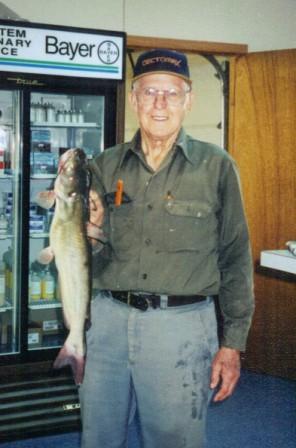
My Grandfather Clyde Myers was also an outdoors man, and loved to spend his free time fishing. We spent several hours together on the bank of a pond with our hooks baited waiting for a big catch. He is the reason I am also an outdoor sportsman.
Grandpa died the day I got back from the 2008 USAWA Nationals in Columbus, Ohio. I was very worried about leaving as I knew he was in bad shape and might not last until I got back. The day before I left he assured me that he would be alright until I got back, and for me to go “give it my all” at the meet. He was always very supportive of my lifting efforts and would listen to all the details of the meets. Well, the day I got back he passed in his sleep. He was one of the most influential men in my life, and helped shape me into the man I am today. There is not a day that passes that I don’t think of him and miss him, but I know his heart was with The Lord and I will see him again.
